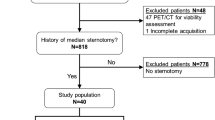Abstract.
Sternal wound infections (SWIs) can be subdivided into two types, superficial or deep, that require different treatments. The clinical diagnosis of superficial SWI is normally easy to perform, whereas the involvement of deep tissues is frequently difficult to detect. Therefore, there is a need for an imaging study that permits the assessment of SWIs and is able to distinguish between superficial and deep SWI. The present work was a prospective study aiming to evaluate the role of technetium-99m hexamethylpropylene amine oxime (99mTc-HMPAO) labelled leucocyte scan in SWI management. Twenty-eight patients with suspected SWIs were included in the study. On the basis of clinical examination they were subdivided into three groups: patients with signs of superficial SWI (group 1), patients with signs of superficial SWI and suspected deep infection (group 2) and patients with suspected deep SWI without superficial involvement (group 3). Ten patients previously submitted to median sternotomy, but without suspected SWI, were also included in the study as a control group (group 4). All patients with suspected SWI had bacteriological examinations of wound secretion, if present. In addition 99mTc-HMPAO labelled leucocyte scan was performed in all patients. The patients of groups 1, 2 and 3 were treated on the basis of the clinical signs and microbiological findings, independently of the scintigraphic results. The patients of group 4 did not receive treatment. The final assessment of infection was based on histological and microbiological findings or on long-term clinical follow-up. Sensitivity, specificity, accuracy and positive and negative predictive values for scintigraphic and non-scintigraphic results were calculated. In the diagnosis of superficial and deep SWI, clinical and microbiological examination (combined) yielded, respectively, a sensitivity of 68.7% and 100%, a specificity of 77.3% and 80.8%, an accuracy of 73.7% and 86.8%, a positive predictive value of 68.7% and 70.6% and a negative predictive value of 77.3% and 100%. The scintigraphic results obtained in superficial SWI yielded a sensitivity of 56.2%, a specificity of 90.9%, an accuracy of 76.3%, a positive predictive value of 81.8% and a negative predictive value of 74.1%, while, by contrast, in deep SWI all of these values were 100%. Therefore, one can conclude that 99mTc-HMPAO labelled leucocyte scan permits accurate diagnosis of deep SWI, solving the main clinical problem in this field. In the present study the categorisation of patients without taking into account 99mTc-HMPAO labelled leucocyte planar scan findings caused a non-negligible number of cases of superficial SWI to be treated as though they were deep SWI. This ”overestimation” led to unnecessary surgery, increased and prolonged use of antibiotics with more (higher) toxicity and additional expense.
Similar content being viewed by others
Author information
Authors and Affiliations
Additional information
Received 6 December 1999 and in revised form 5 February 2000
Rights and permissions
About this article
Cite this article
Liberatore, M., Fiore, V., D’Agostini, A. et al. Sternal wound infection revisited. Eur J Nucl Med 27, 660–667 (2000). https://doi.org/10.1007/s002590050560
Issue Date:
DOI: https://doi.org/10.1007/s002590050560




